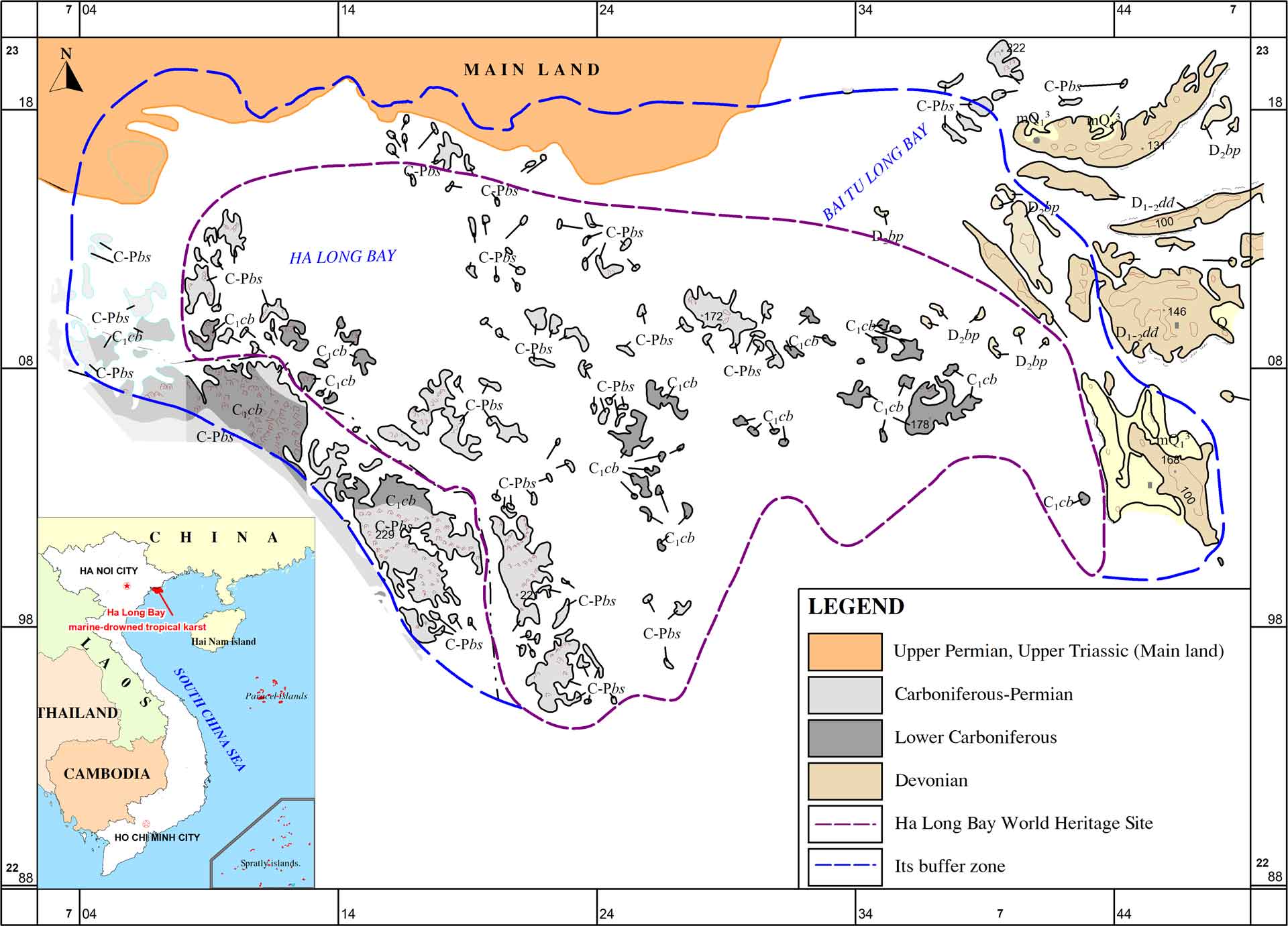
Part of the spectacular drowned seascape of thousands of islands and islets of Ha Long Bay (Photo: @Xuan Thuy).
Geological Period
Neogene to Quaternary
Main geological interest
Geomorphology and active geological processes
Location
Quang Ninh Province and Hai Phong City, in the Gulf of Tonkin, Vietnam
20°54’00”N, 107°06’00”E
Part of the spectacular drowned seascape of thousands of islands and islets of Ha Long Bay (Photo: @Xuan Thuy).
The most extensive and best known example of marine-invaded tower karst in the world.
Ha Long Bay-Cat Ba Archipelago is one of the world’s most extensive areas of cone and tower karst that displays the full range of karst formation processes. The outstanding feature of this ideal model of mature tropical karst is that it had developed on-land before being repeatedly invaded and reworked by recent marine transgressions-regressions, and remains at present a drowned seascape of karst landforms. Clusters of inter-connected cones and isolated towers become islands and islets, intra-mountain depressions become “closed lakes” and fault-controlled valleys become “channels”. The site provides unique understanding of the complex geo-bio-climatic history and karst processes.
- Geological description
Ha Long Bay-Cat Ba Archipelago (Quang Ninh Province and Hai Phong City, in the Gulf of Tonkin, Northeast Vietnam) is located ca. 150 kilometers from Hanoi capital. Covering an area of ca. 2,000km2 and including ca. 2,000 islands and islets, mostly made of Lower Carboniferous and Carboniferous-Permian limestones and mostly uninhabited and unaffected by humans, Ha Long Bay-Cat Ba Archipelago is a spectacular seascape of limestone pillars, cones and towers of tremendous diversity of forms and shapes, of which Cat Ba Island (Hai Phong City), ca. 200km2 in area, is the largest. Between the pillars, cones and towers are numerous marine closed lakes and fault-controled channels. Many large-sized islands feature several levels of essentially dry, caves that had been formed on-land, while most islands and islets are carved in by several levels of sea notches and “foot-caves” that are actively formed by the current sea actions. The exceptional scenic beauty of the site is complemented by its great biodiversity. Three archaeological cultures, i.e. Soi Nhu (18,000-7,000 years AD), Cai Beo (7,000-5,000 AD) and Ha Long (5,000-3,500 AD), interrupted perhaps by repeated sea level fluctuations and climate changes, have been identified in this area.
- Scientific research and tradition
Having been used since ancient time and subjected to first scientific studies since 1898 by the French, at present Ha Long Bay-Cat Ba Archipelago is still being systematically surveyed and studied. The central part, ca. 650km2, of Ha Long Bay-Cat Ba Archipelago became a UNESCO World Natural Heritage three times thanks to its aesthetic (in 1994), geologic-geomorphologic (in 2000) and biodiversity (in 2023) values.
- Reference
Tran Duc Thanh (1998) Geological history of Ha Long Bay. Hai Phong Institute of Oceanology, National Centre for Natural Science and Technology of Vietnam.
Tran Duc Thanh and Waltham, T. (2000) The outstanding value of geology of Ha Long Bay. Proceedings of workshop on “Five years of Ha Long Bay World Heritage”. Ha Long City: Quang Ninh Provincial People’s Committee, Ministry of Culture and Information, and Vietnam National Commission for UNESCO.
Tran Van Tri et al. (2003) ‘The Ha Long Bay World Heritage: Oustanding Geological Values’, Journal of Geology, 22, pp. 1–18.
Tran Van Tri and Dang Vu Khuc (eds) (2011) Geology and Earth Resources of Viet Nam. Ha Noi: Natural Science and Techonology Publishing House.
UNESCO (no date) ‘UNESCO World Heritage page for Ha Long Bay’. Available at: https://whc.unesco.org/en/list/672.
Waltham, T. (1998) Limestone karst of Ha Long Bay, Vietnam. An assessment of the karst geomorphology of the World Heritage Site for the World Conservation Union and The Management Department of Ha Long Bay. Engineering Geology Report 806. Nottingham Trent University, UK.
- Author(s)
Tran Tan Van.
Vietnam Institute of Geosciences and Mineral Resources.
Do Thi Yen Ngoc.
Vietnam Institute of Geosciences and Mineral Resources.
Pham Thi Thuy.
Vietnam Institute of Geosciences and Mineral Resources.
Tran Duc Thanh.
Institute of Marine Environment and Resources. Vietnam.
Tran Van Tri.
Vietnam Union of Geological Sciences.
Vu Kien Cuong.
Ha Long Bay Management Department. Vietnam.

